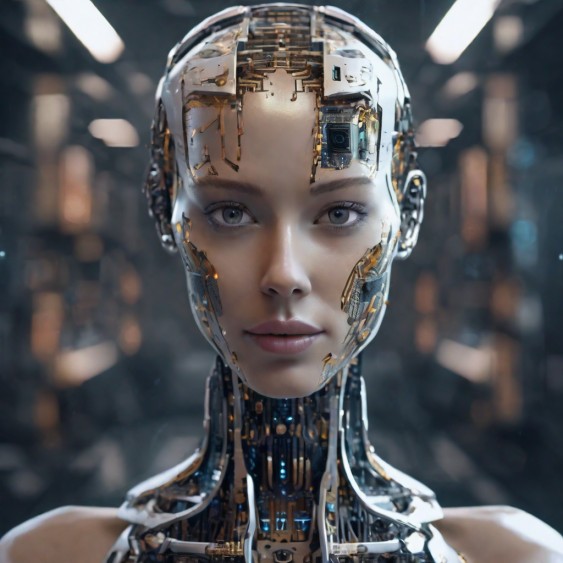
Decoding the Benefits: Why AI is Good for Our Future
Updated May 16, 2024
Introduction:
Artificial Intelligence (AI) has evolved from a futuristic speculation to an everyday reality, permeating every aspect of our lives. From simplifying mundane chores to revolutionizing complex financial structures, AI’s impact is far-reaching and transformative. The question is no longer about the feasibility of AI but rather, “Why is it good.”
Its potential benefits are manifold. For instance, AI has been instrumental in the medical field, where Google uses it to diagnose heart disease more quickly and accurately. In the financial sector, hedge funds use AI to beat the stock market. Even in customer service, companies like American Express deploy AI bots to serve customers online.
AI’s influence also extends to the education sector, where it’s being used to customize educational software according to student’s needs and capabilities, making education accessible to everyone worldwide without language barriers.
However, the benefits of Artificial Intelligence are not without challenges. Concerns about privacy, data collection, and potential misuse are real and must be addressed responsibly. Despite these challenges, the consensus among experts is that AI can significantly benefit society if implemented responsibly.
The future of Artifical Intelligence is a rapidly changing landscape, with innovations that have the potential to reshape our world in ways we might not yet fully comprehend. As we continue integrating AI into our lives, it’s crucial to understand its benefits, address its challenges, and prepare for a future where AI plays an even more significant role.
Embracing AI: The Acceleration of Processing Speeds
Imagine a world where complex calculations take mere seconds, where the vast expanse of the internet can be navigated instantaneously to provide precise information. This isn’t a far-off dream; this is the reality of Artifical Intelligence. AI’s astounding processing speeds enhance efficiency and free human resources for more creative and critical tasks.
Artifical Intelligence accelerators, such as Graphics Processing Units (GPUs), are specialized hardware designed to handle the parallel tasks involved in machine learning, making them famous for AI work. These accelerators have been increasingly applied to AI acceleration, with manufacturers incorporating neural network-specific hardware to speed up these tasks further. This has led to near-instantaneous results, making AI applications valuable in various sectors.
For instance, rapid data processing and analysis are essential in finance. AI’s accelerated processing speeds allow for real-time fraud detection, personalized recommendations, and demand forecasting. These capabilities are invaluable in an industry where speed and accuracy can make a significant difference.
Edge inferencing, another application of Artifical Intelligence, is exploding across intelligent surveillance, autonomous machines, and various real-time IoT applications. This technology allows for the deployment of trained models for inference, which are modified, optimized, and simplified based on where they are being deployed. This results in optimal AI inference performance, further showcasing the benefits of AI’s accelerated processing speeds.
Artifical Intelligence in Healthcare: The Dawn of Novel Treatments
The healthcare sector is another area that bolsters the notion of ‘Why it’s Good.’ AI has immense potential to revolutionize this industry, and we are already witnessing its transformative effects.
AI is employed to predict potential health risks, diagnose diseases with a higher degree of accuracy, and pioneer novel treatments. For instance, AI’s ability to quickly analyze vast amounts of clinical documentation helps medical professionals identify disease markers and trends that would otherwise be overlooked. This has led to more accurate diagnoses and more personalized treatments.
One of the most promising applications of Artificial Intelligence in healthcare is genomics. AI is enabling personalized medicine by tailoring treatments to individual genetic makeups. This not only enhances the efficacy of treatments but also minimizes side effects. Companies like Tempus use AI to sift through the world’s most extensive clinical and molecular data collection to personalize healthcare treatments.
Artifical Intelligence is also used to optimize hospital efficiency and improve patient experiences. IBM’s Watson, for instance, applies its skills to everything from developing personalized health plans to interpreting genetic testing results and catching early signs of disease.
Moreover, Artificial Intelligence is are transforming how healthcare is delivered by shifting the model from a reactive to a proactive approach. This focus on health management rather than disease treatment is expected to result in fewer hospitalizations, doctor visits, and treatments. AI-based technology is vital in helping people stay healthy via continuous monitoring and coaching, ensuring earlier diagnosis, tailored treatments, and more efficient follow-ups.
AI: A Beacon of Hope for Poverty Alleviation
The argument for ‘Why it’s Good’ extends beyond technology and healthcare to socio-economic issues like poverty. AI’s ability to analyze vast amounts of data to identify patterns and formulate solutions is a beacon of hope for poverty eradication. For instance, AI is being used to predict storm trajectories and track the spread of diseases, both of which hit poor communities especially hard.
AI can guide governmental actions towards more impactful strategies by predicting and tracking the impact of socio-economic policies. This could accelerate the fight against poverty. For example, AI could help determine the most effective distribution of resources, such as whether it’s better for a struggling single mother to receive education, training, and food stamps or for her children to receive early childhood education and Medicaid.
The Equality Proposition: AI as an Egalitarian Tool
The premise that ‘Why it’s Good’ is reinforced by its potential to foster equality. AI can help eliminate bias in decision-making processes. In the financial sector, AI-driven algorithms can assess creditworthiness based on objective criteria, eliminating human bias. This could democratize access to financial services, promoting social and economic equality.
AI’s potential to foster equality extends to education as well. Intelligent chatbots could stand in as teachers for students without access to other forms of schooling, eradicating financial barriers and inequality many worldwide face in education.
AI in Education: Personalizing Learning Paths
AI’s potential to personalize learning paths in education fortifies the assertion, ‘Why it’s Good.’ AI can adapt educational content to cater to each student’s unique learning style and pace, ensuring no learner is left behind.
AI technologies can analyze student data and learning patterns to create personalized learning experiences. This ensures students receive content and instruction tailored to their abilities and interests. For instance, if a student struggles with a specific math concept, AI-powered platforms can provide remedial materials and adaptive exercises to reinforce understanding.
AI’s ability to adapt to students’ specific needs is one of its primary advantages in personalized learning. It can identify knowledge gaps and offer targeted support, enabling students to progress independently. This tailoring of education to individual needs is a significant benefit of AI in education.
For example, AI-powered educational platforms can track students’ progress and provide tailored feedback, enhancing learning outcomes. If a student struggles with a particular concept or task within the virtual environment, its algorithm can detect their difficulty and offer targeted hints or explanations. The algorithm can adapt the level of challenge based on the student’s progress, ensuring that they are appropriately challenged without becoming overwhelmed.
Climate Change Mitigation: AI to the Rescue
In the fight against climate change, AI can play a pivotal role, reinforcing ‘Why it’s Good.’ AI algorithms can help model complex climate systems, making predictions more accurate. They can also optimize renewable energy production and consumption and even track deforestation in real-time, aiding efforts to protect our planet.
AI’s ability to analyze vast amounts of data and identify patterns is instrumental in modelling complex climate systems. This can lead to more accurate predictions about climate change and its impacts, enabling us to prepare and adapt more effectively.
AI can also play a significant role in optimizing renewable energy production and consumption. AI-driven smart grids can balance supply and demand, facilitating the integration of renewables into energy systems and reducing the reliance on fossil fuels. This can significantly contribute to reducing greenhouse gas emissions and mitigating climate change.
Moreover, AI can be used to track deforestation in real time. This can provide valuable data for conservation efforts and help hold those responsible for illegal deforestation accountable.
AI in Agriculture: Feeding the Future
Another sector that manifests ‘Why it’s Good is agriculture. AI can significantly enhance yield prediction, crop health monitoring, and resource allocation. This not only increases productivity but also ensures sustainable farming practices.
AI’s ability to analyze vast amounts of data and identify patterns is instrumental in agriculture. For instance, AI can use plant growth data to advise on crops that are more resilient to extreme weather, disease, or harmful pests. This can lead to more robust and productive crops, thereby increasing yield.
AI algorithms can also analyze the chemical composition of soil samples to determine which nutrients may be lacking. This can help farmers optimize their use of fertilizers and other agronomic products, ensuring that crops receive the necessary nutrients while minimizing waste and environmental impact.
Moreover, AI can be used to monitor crop health and detect diseases. AI-powered drones, for instance, can monitor crop health and deliver targeted treatment, reducing wastage and environmental impact. This can significantly improve crop yields and reduce food production costs.
It can even predict the best time to harvest crops, ensuring farmers can maximize their yield and reduce waste. This can be particularly beneficial in regions where farming is a significant part of the economy.
Public Safety and AI: A Safer Tomorrow
From predictive policing that can anticipate crime hotspots to AI-driven surveillance systems that detect unusual behaviour, AI can significantly bolster public security.
Predictive policing, powered by AI, is no longer a far-fetched concept. AI can support preventive policing by employing pattern recognition to stop crimes before they materialize. This can create a safer community by anticipating crime hotspots and enabling law enforcement to take proactive measures.
AI-driven surveillance systems can also enhance public safety. These systems can detect unusual behaviour or potential threats more quickly and effectively, offering real-time support to first responders. This includes tasks that would otherwise be difficult for humans, such as crowd estimation, weapon detection, identifying critical hardware failures, and enhancing investigations.
Furthermore, AI can aid disaster management by predicting natural disasters, allowing for timely evacuations and better resource allocation. Over the past years, researchers have leveraged AI to develop models and applications to identify, assess, predict, monitor, and detect hazards to inform emergency response operations and decision-making.
AI in Transportation: The Journey to Efficiency
The transportation sector also significantly benefits from AI, reinforcing ‘Why it’s Good.’ Autonomous vehicles powered by AI can drastically reduce accidents caused by human error. AI can also optimize traffic flow, reducing congestion and resulting in less wasted time and lower carbon emissions.
AI’s role in autonomous vehicles is a game-changer for the transportation industry. These self-driving vehicles can detect traffic, pedestrians, and cyclists, significantly reducing the risk of accidents. The majority of car accidents are due to human error, and autonomous vehicles have the potential to save thousands of lives by eliminating this factor.
AI also plays a crucial role in traffic management. AI-powered traffic management systems can analyze real-time data, predict changing traffic patterns, and adjust signals accordingly. This can lead to less congested routes, smoother traffic flow, and more efficient use of public and private transportation services. The result is less wasted time, lower carbon emissions, and improved overall transportation efficiency.
Furthermore, AI can enhance passenger safety and security. Continuous traffic flow monitoring can prevent problems and improve safety. AI can also predict security threats and unforeseen occurrences in traffic, allowing for timely interventions.
Contrarian Investing and AI: A New Perspective
From a financial analyst’s perspective, AI’s potential lies in its ability to understand and predict mass psychology—a critical factor in contrarian investing. Contrarian investors swim against the current, buying when others sell and vice versa. AI can analyze market sentiment, enabling investors to identify opportunities others might overlook, thus reinforcing ‘Why it’s Good’ for financial market dynamics.
Contrarian investing is an investment style where investors purposefully go against prevailing market sentiments. When the market buys, they sell, and vice versa. This approach is based on the belief that the market often overreacts to good and bad news, causing stock price movements in the short term that don’t correspond to a company’s long-term fundamentals.
AI can play a significant role in contrarian investing by analyzing market sentiment. AI algorithms can process vast amounts of data from various sources, including news articles, social media posts, and financial reports, to gauge the overall sentiment towards a particular stock or the market. This can help contrarian investors identify when the market sentiment is overly optimistic or pessimistic, providing potential investment opportunities.
Moreover, AI can help contrarian investors by predicting market trends based on historical data and current market conditions. This can enable investors to make more informed decisions and reap significant gains.
Conclusion
The transformative power of AI is unquestionable. Its potential to revolutionize processing speeds, pioneer treatments, eradicate poverty, and foster equality underscores ‘Why it’s Good’. But perhaps the most compelling reason is its capacity to evolve, learn, and adapt, mirroring and, in some cases, surpassing the most distinctive human traits.
From agriculture to public safety, transportation to investing, and beyond, Its influence is rapidly permeating every sector of our society. Its ability to process and analyze vast amounts of data can enhance decision-making, improve efficiencies, and unlock new opportunities.
It helps optimize yield prediction, crop health monitoring, and resource allocation in agriculture, ensuring sustainable farming practices. In public safety, AI aids in predictive policing, surveillance, and disaster management, bolstering security and resilience. AI’s role in autonomous vehicles and traffic management in transportation promises safer and more efficient movement. And in financial markets, AI’s ability to analyze sentiment is valuable for contrarian investing.
However, AI’s potential extends far beyond these applications. Its capacity to evolve, learn, and adapt—mirroring and sometimes surpassing the most distinctive human traits—holds promise for numerous future advancements. Whether it’s developing new treatments in healthcare, reducing carbon emissions in environmental sustainability, or combating poverty and inequality, the possibilities are boundless.
As we stand on the precipice of a new era, the discourse is not about whether to embrace AI but about understanding ‘Why it’s Good. As we continue to embrace and refine this powerful technology, we pave the way for a more productive, efficient, safe, and equitable future. ‘Why it’s Good’ is a question with an increasingly clear answer: It can significantly improve our world and the lives of all individuals within it.












